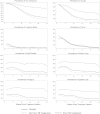Tuberculosis treatment discontinuation and symptom persistence: an observational study of Bihar, India's public care system covering >100,000,000 inhabitants
- PMID: 24886314
- PMCID: PMC4041057
- DOI: 10.1186/1471-2458-14-418
Tuberculosis treatment discontinuation and symptom persistence: an observational study of Bihar, India's public care system covering >100,000,000 inhabitants
Abstract
Background: The effectiveness of India's TB control programs depend critically on patients completing appropriate treatment. Discontinuing treatment prior to completion can leave patients infectious and symptomatic. Developing strategies to reduce early discontinuation requires characterizing its patterns and their link to symptom persistence.
Methods: The 2011 BEST-TB survey (360 clusters, 11 districts) sampled patients (n = 1007) from Bihar's public healthcare system who had initiated treatment >6 months prior to being interviewed, administering questionnaires to patients about TB treatment duration and symptoms, prior treatment, and sociodemographic characteristics. Multivariate logistic regression models estimated the risk of treatment discontinuation for these characteristics. Similar models estimated probabilities of symptom persistence to 25 weeks post-treatment initiation adjusting for the same predictors and treatment duration. All models included district fixed effects, robust standard errors, and adjustments for the survey sampling design. Treatment default timing and symptom persistence relied solely on self-report.
Results: 24% of patients discontinued treatment prior to 25 weeks. Higher likelihood of discontinuation occurred in those who had failed to complete previous TB treatment episodes (aOR: 4.77 [95% CI: 1.98-11.53]) and those seeing multiple providers (3.67 per provider [1.94-6.95]). Symptoms persisted in 42% of patients discontinuing treatment within 5 weeks versus 28% for completing 25 weeks of treatment. Symptom persistence was more likely for those with prior TB treatment (aOR: 5.05 [1.90-13.38]); poorer patients (2.94 [1.51-5.72]); and women (1.79 [1.07-2.99]). Predictors for treatment discontinuation prior to 16 weeks were similar.
Conclusions: Premature TB treatment discontinuation and symptom persistence is particularly high among individuals who have failed to complete treatment for a prior episode. Strategies to identify and promote treatment completion in this group appear promising. Likewise, effective TB regimens of shortened duration currently in trials may eventually help to achieve higher treatment completion rates.
Figures



Similar articles
-
Delays to anti-tuberculosis treatment intiation among cases on directly observed treatment short course in districts of southwestern Ethiopia: a cross sectional study.BMC Infect Dis. 2019 May 29;19(1):481. doi: 10.1186/s12879-019-4089-x. BMC Infect Dis. 2019. PMID: 31142288 Free PMC article.
-
Tuberculosis (TB) Aftermath: study protocol for a hybrid type I effectiveness-implementation non-inferiority randomized trial in India comparing two active case finding (ACF) strategies among individuals treated for TB and their household contacts.Trials. 2022 Aug 5;23(1):635. doi: 10.1186/s13063-022-06503-6. Trials. 2022. PMID: 35932062 Free PMC article.
-
Tuberculosis patients not covered by treatment in public health services: findings from India's National Family Health Survey 2015-16.Trop Med Int Health. 2018 Aug;23(8):886-895. doi: 10.1111/tmi.13086. Epub 2018 Jun 25. Trop Med Int Health. 2018. PMID: 29851437 Free PMC article.
-
Linezolid for drug-resistant pulmonary tuberculosis.Cochrane Database Syst Rev. 2019 Mar 20;3(3):CD012836. doi: 10.1002/14651858.CD012836.pub2. Cochrane Database Syst Rev. 2019. PMID: 30893466 Free PMC article.
-
Approaches for discontinuation versus continuation of long-term antidepressant use for depressive and anxiety disorders in adults.Cochrane Database Syst Rev. 2021 Apr 15;4(4):CD013495. doi: 10.1002/14651858.CD013495.pub2. Cochrane Database Syst Rev. 2021. PMID: 33886130 Free PMC article.
Cited by
-
Oral anti-tuberculosis drugs: An urgent medication reconciliation at hospitals in Indonesia.J Public Health Res. 2021 Aug 11;10(3):1896. doi: 10.4081/jphr.2021.1896. J Public Health Res. 2021. PMID: 34463088 Free PMC article.
-
Optimal timing of drug sensitivity testing for patients on first-line tuberculosis treatment.Health Care Manag Sci. 2018 Dec;21(4):632-646. doi: 10.1007/s10729-017-9416-4. Epub 2017 Aug 31. Health Care Manag Sci. 2018. PMID: 28861650 Free PMC article.
-
Financial impact of COVID-19 on TB patients in India.Int J Tuberc Lung Dis. 2022 Mar 1;26(3):285-287. doi: 10.5588/ijtld.21.0658. Int J Tuberc Lung Dis. 2022. PMID: 35197171 Free PMC article. No abstract available.
-
Toward Developing a Standardized Core Set of Outcome Measures in Mobile Health Interventions for Tuberculosis Management: Systematic Review.JMIR Mhealth Uhealth. 2019 Feb 19;7(2):e12385. doi: 10.2196/12385. JMIR Mhealth Uhealth. 2019. PMID: 30777847 Free PMC article.
-
Tuberculosis and Diabetes in India: Stakeholder Perspectives on Health System Challenges and Opportunities for Integrated Care.J Epidemiol Glob Health. 2022 Mar;12(1):104-112. doi: 10.1007/s44197-021-00025-1. Epub 2022 Jan 10. J Epidemiol Glob Health. 2022. PMID: 35006580 Free PMC article.
References
-
- World Health Organization. Global Tuberculosis Control 2011. Geneva: World Health Organization; 2011.
-
- Government of India Ministry of Health and Family Welfare: Central TB Division. TB India 2011: Revised National TB Control Programme Annual Status Report. New Delhi, India: Government of India Ministry of Health and Family Welfare; 2010.
-
- Crofton J, Chaulet P, Maher D. Guidelines for The Management Of Drug-Resistant Tuberculosis. Geneva: World Health Organization; 1997.
-
- Heym B, Honore N, Truffot-Pernot C, Banerjee A, Schurra C, Jacobs WR Jr, van Embden JD, Grosset JH, Cole ST. Implications of multidrug resistance for the future of short-course chemotherapy of tuberculosis: a molecular study. Lancet. 1994;344(8918):293–298. doi: 10.1016/S0140-6736(94)91338-2. - DOI - PubMed
-
- Rowland K. Nature News. 2012 2012. Totally Drug-Resistant TB Emerges in India.
Publication types
MeSH terms
Grants and funding
LinkOut - more resources
Full Text Sources
Other Literature Sources
Medical

